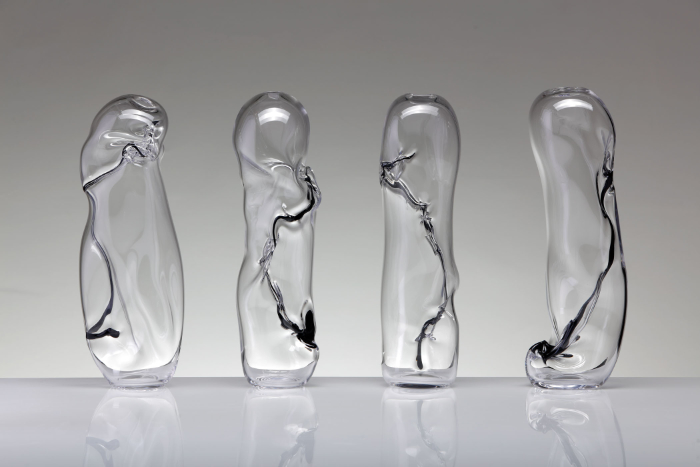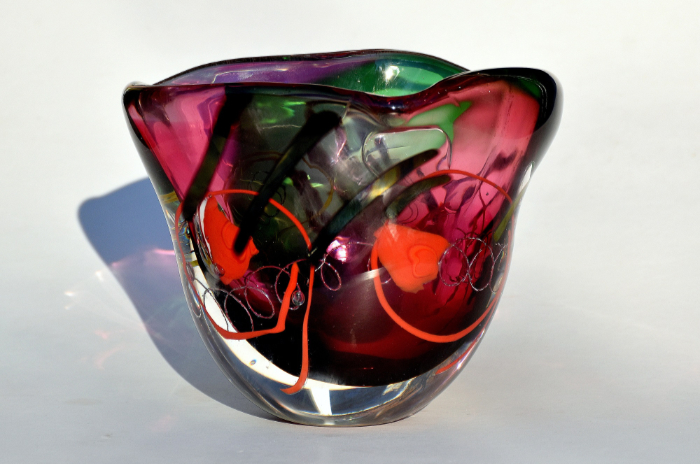
Dancing with chance
Richard Roberts’ creative journey with glass was sparked by watching a glassblowing demonstration. This inspired him to learn the craft and, after trying glassblowing, he specialised in cast glass processes before the freedom and immediacy of glassblowing tempted him back. Here, Richard explains more about how his practice has evolved.
My journey with creative glass started by chance when I saw a glassblowing demonstration at the Red House Cone in Stourbridge, West Midlands, back in 2008. I was immediately mesmerised by the molten glass and how it could be manipulated, and said to myself, “I want to do that.” I enrolled at Dudley College the following year.
I attended a City and Guilds course in 2009-2010 and followed this with the Associateship in Glass course from 2010-11. This was when I started to learn glassblowing and open cast Petrobond sand casting, which I found extremely tricky and frustrating as there were so many imperfections in the finished pieces. I cast an Art Deco-inspired elephant and that later expanded into a range of open cast animals. This led me to try kiln-cast glass (effectively the lost wax process) when I started my MA in glass at Wolverhampton University the following year.
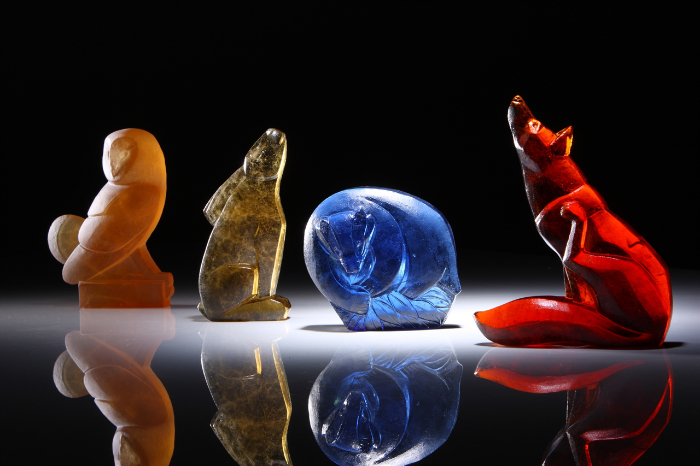
I’ve always found glassblowing extremely difficult, so I guess I took the easy option of making glass sculptures on my MA. I had been a commercial sculptor previously – designing and modelling figurative originals for porcelain and resin limited editions and mass production – so making glass sculptures came naturally to me.
Over three years I ended up pushing the technical limits of kiln-cast glass and then core casting. Core casting is when you create an empty space in the body of the glass but it appears as a solid object within it, as used in my piece ‘Rain Reveller’.
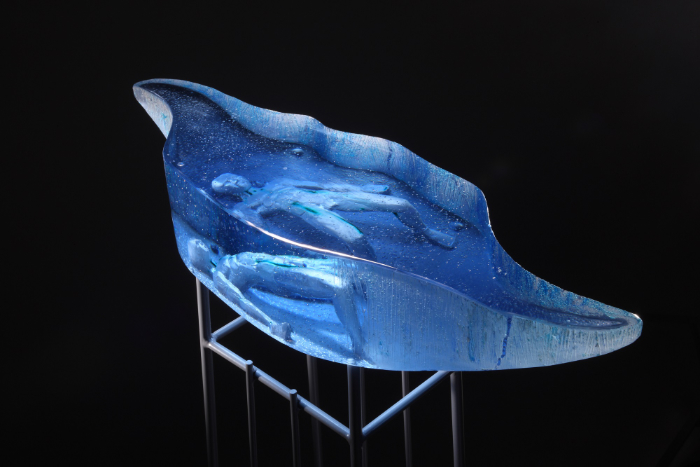
At my final MA assessment, the table consisted of an array of fragmented failures where I had pushed the technical feasible limits of core casting. Fortunately, I don’t think it affected my grade.
In addition, along the way, I had produced a body of work including ‘Young Minotaur in Arcadia’, ‘Fishman’, ‘Flying Fishman’ and ‘Triton & Siren’. I’m a keen regular swimmer, and played water polo at the time, so I wanted to explore designs featuring the human figure in watery environments, and I tried to express haptic sensations of being in water. This developed into a planned quartet of works revolving around the four elements of nature: wind/air, water, earth and fire.
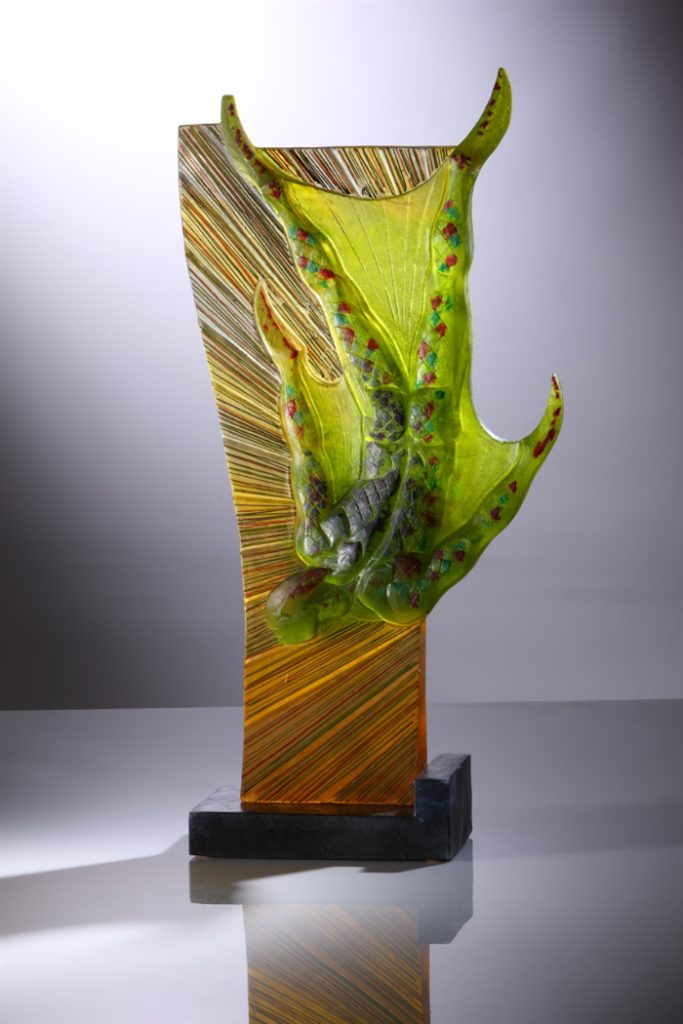
My piece ‘Aquatic Tondo’ was made using the centrifugal resin sand casting process, wherein molten glass was poured into a mould and immediately spun around at high speed until the glass solidified or reached the sides. This was an exciting and unpredictable technique that was a bit of a hit-or-miss event.
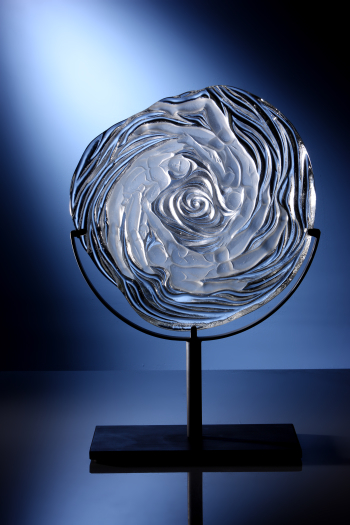
Later, I became an Artist in Residence at Wolverhampton University and reverted back to ‘simpler’ kiln-casting methods to make a set of animal/human composite figures. A Minotaur, ‘Foxman’, ‘Ravenman’ and an ‘Owlman’ that I called ‘An Encounter of Curiosity’. Even these pieces were not without their technical challenges.
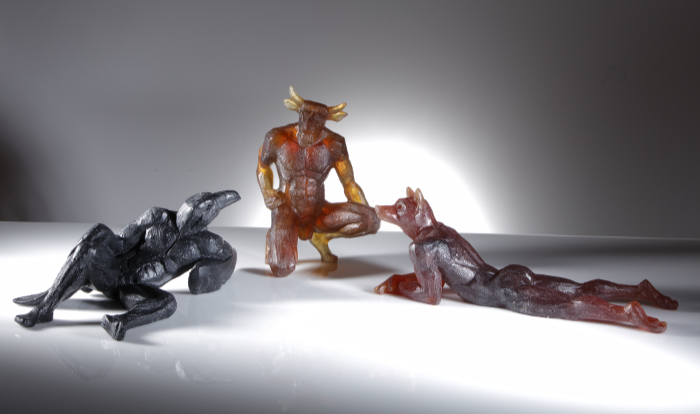
After making these glass sculptures that entailed lengthy mould-making and coldworking processes, I longed for the immediacy of glassblowing – even though this method presented its own difficulties.
Glassblowing is where my practice is focused now, with some fused glass work. I’ve returned to Dudley College for the Associateship in Glass course, which involved a forced two-year break during the pandemic.
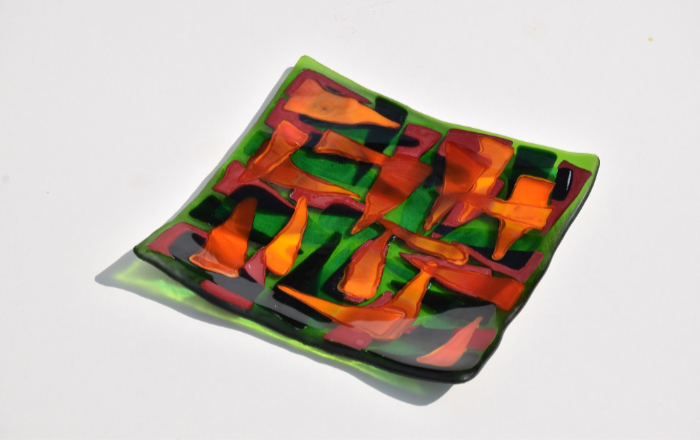
In my previous life in the sphere of commercial figurative sculpture, whether it involved design on my part or not, I had to work within very strict parameters and had no say about the colour of the product. I created a range of bronzes and tried to use some colourful patinas instead of the regular bronze colour, but the field was limited. In contrast, glassblowing offers the opportunity to use colour; I was like a child in a toy shop. Paintings by El Greco, Pierre Bonnard, Howard Hodgkin and Patrick Heron, among many other painters, as well as our garden (created by my partner Mike and, to a much lesser extent, me), have inspired the use of colours in my blown glass pieces. We have plants in flower every day of the year and plenty of evergreens to clothe the garden well in winter. In gardening you learn how to use complementary colours in a pleasing way. This is very dependent on personal ‘taste’, but it always helps to use occasional flashes of slightly discordant colours as accents to enliven a flower border or a piece of glass.
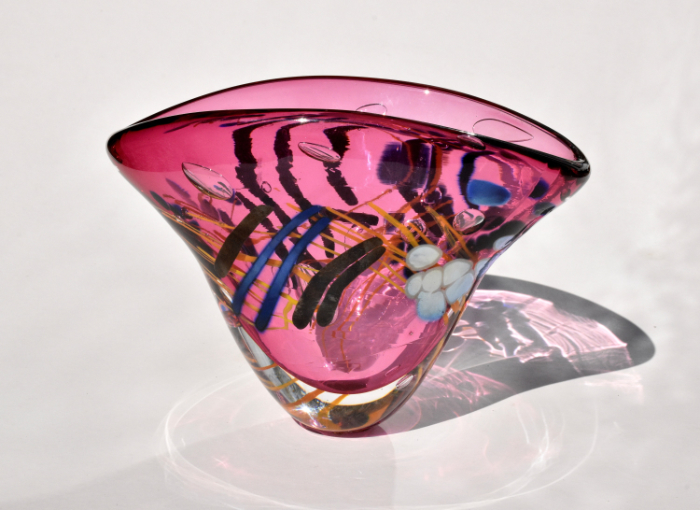
Full circle
I feel I’ve come full circle and returned to the wonder of seeing the ‘alive’ molten glass during that first glassblowing demonstration at the Red House Cone 15 years ago. I never tire of the properties of glass – at one moment a fluid in flux, and in my hands an unpredictable substance, and then a fixed, solid, frozen entity leaving me with the memories and history of its manipulation.
I try to use a variety of elements, such as bubbles, trails, stringers, glass spring sections, frits, glass chips and offcuts, plus copper wires and foils in layers to emphasise the transparency and original fluidity of the glass. In particular, I like using metallic stringers or trails on the surface too. My aim here is to separate the surface from the activity inside. The idea is for my pieces to express fluid movement and flux.
Ironically, acknowledging my technical limitations with glassblowing has given me a lot of freedom to break the rules and – being at a certain mature age – not be bothered about what other people think. I am free from being relentlessly judged by others in the restrictive world of commercial decorative objet d’art.
Much planning goes into my blown glass pieces, but inevitably they never turn out quite how I expected. I find myself dancing with chance, for better or worse, but that’s the frustration and the obsessive attraction of glass. It’s essential that the hand of a human being is at work. To my shame, I hadn’t come across the work of Sam Herman, one of the pioneers of the studio glassblowing movement, until five years ago. His work certainly encouraged me to try and be more free and loose with form and content. It’s good see the work of other glass artists from around the world on Instagram, which reassures me that what I’m trying to do, in my modest way, isn’t quite so daft.

Sales and exhibitions
In the past, I sold my work in galleries in Much Wenlock, Cornwall and Hay-on Wye, and exhibited in London and at the International Festival of Glass in Stourbridge. For three years I exhibited at the Oak Hall at Westonbirt Arboretum with a group of glass and ceramic students who had also studied at Wolverhampton University, which proved successful.
More recently, I’ve done well at the Midlands Art Centre (MAC) pre-Christmas Arts Markets in Birmingham. It’s great to meet customers and to see how they react to my work. Such support is very encouraging and inspires me to carry on ploughing my own creative furrow with glass.
About the artist
Richard Roberts is based in Walsall, West Midlands. See more of his work on his website: https://www.richardrobertsglass.co.uk/ or via Instagram: @Richard.Roberts1
Main feature image: ‘Blown Piece 7’ includes metallic stringers, circles, chips, bubbles and copper wire and is one Richard’s latest pieces. Photo by the artist.
